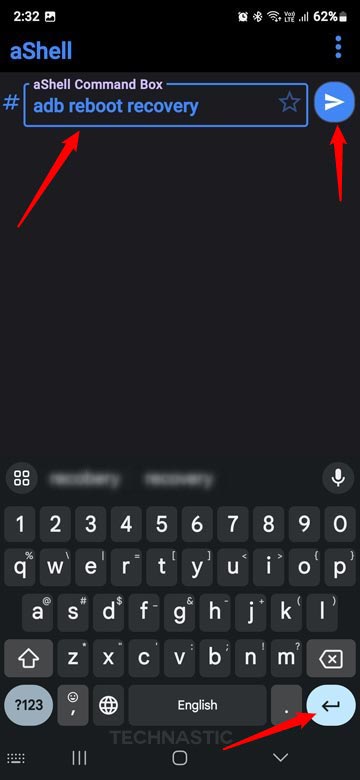- Turn off your Galaxy device, connect it to a PC via USB, and hold the Volume Up + Power keys together. Keep both keys pressed until you see the Samsung Galaxy logo, and release them.
- The
adb reboot recoverycommand boots any Android device into the Recovery Mode. - You can also use tools like ADB AppControl and Web ADB to enter the stock Recovery Mode on Android devices.
Like all Android devices, Samsung phones and tablets have a Recovery Mode. It consists of options to perform a factory reset, wipe the system cache, sideload OTA zips, etc. You can hard reset your device via the Recovery Mode to fix bootloop, overheating issues, or performance lag. Here are 6 methods to get into Recovery Mode on your Samsung Galaxy phone using the hardware key combination, the ADB AppControl tool, and commands.
Similarly, you can boot into the Samsung Download Mode to flash firmware via Odin. Below, I have explained all 5 methods in detail.
1. Using Hardware Key Combination
Before we examine other methods to boot the Recovery Mode on Samsung Galaxy devices, let’s check the hardware key combinations.
On Samsung Galaxy S22 and Newer Phones
If you own a Samsung phone released after 2021, using the old hardware key combination will not work. Here’s how to boot a Galaxy S22, S23, S24, S25, or newer Galaxy device into Recovery Mode.
- Turn off your Samsung device.
- Connect your phone to your computer using a USB cable and instantly hold the Volume Up and Power keys simultaneously.
- When the Samsung Galaxy logo shows on your phone’s screen, release both keys and wait until the Recovery Menu appears.
Alternatively, you can try the following method without turning off your phone.
- Connect your Samsung Galaxy phone to a computer using a USB cable.
- Swipe down from the status bar to open the Quick Settings page and tap the Power icon to open the Power Menu.
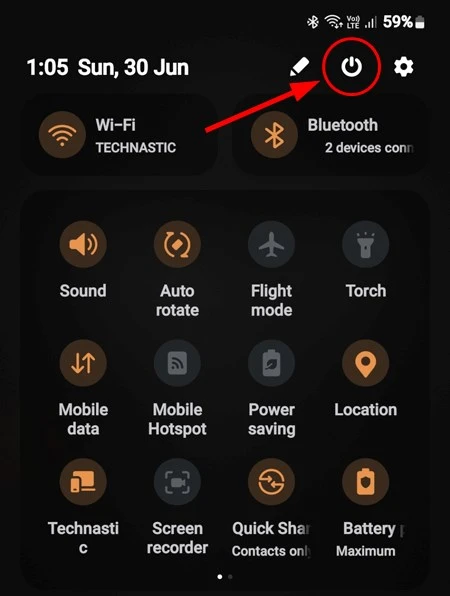
- Tap the Reboot option.
- When the phone’s screen turns black, hold the Volume Up + Power buttons simultaneously.
- Keep the buttons pressed until you see the Samsung Galaxy screen.
- Release both keys, and your Samsung phone will enter the Recovery Mode.
Samsung Devices with Volume and Power/Bixby Keys
On high-end Samsung devices like Galaxy S20, Note 10, Galaxy A80, etc., you can enter the Recovery Mode as follows.
2. Using aShell Terminal App
If you are an Android enthusiast and don’t use Shizuku, you are missing out on a great way to tweak and customize your device without root.
- Follow our guide to set up Shizuku on your Android phone.
- Install the aShell terminal app from the Play Store (paid) or F-Droid (free).
- Open aShell and allow it to access Shizuku.
- Tap the aShell command box, type the following command, and tap the Send button or Enter key on your Keyboard.
adb reboot recovery
That’s it. Your device will reboot into the stock recovery.
3. Boot into Recovery via ADB
ADB commands can perform various advanced tasks. They can also help you reboot Android devices into Recovery Mode. Needless to mention, you’ll need a PC or laptop to do this.
- Download the latest Android SDK Platform-tools.zip for your Windows, macOS, or Linux computer and extract it on your desktop.
- Navigate to the platform-tools folder that contains the ADB and Fastboot files.
- Type “powershell” in the folder address bar and press Enter to launch a command window.
- Install the Samsung USB driver on your computer and enable USB debugging on the device.
- Connect your Samsung phone or tablet to the computer via the USB cable that came with your device.
- Execute the following command to check if your device is properly connected to the ADB server.
adb devices
- Now type the following command and press the Enter key on your keyboard.
adb reboot recovery
- Your Samsung Galaxy phone or tablet will reboot into Recovery Mode without pressing the hardware keys.
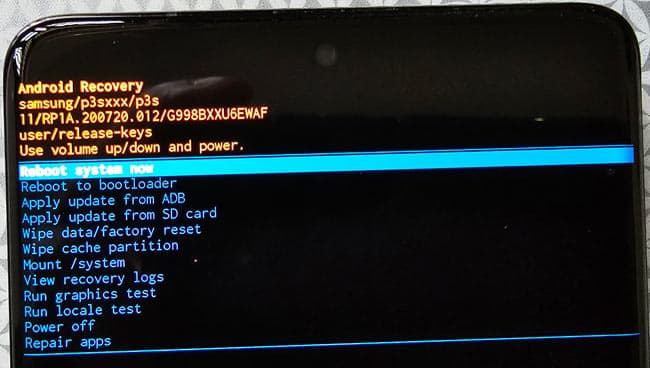
Note: You can exit the Recovery Mode on Samsung devices by selecting the Reboot System Now option.
4. Using ADB AppControl
If using the ADB method seems too complicated, there’s an easier way to reboot into the Recovery Mode without hardware keys. You can use a multi-purpose tool named ADB AppControl for the purpose.
- Install the free or premium version of ADB AppControl.
- Launch the tool when it’s installed.
- Click Tools > Reboot and select ‘recovery‘ from the drop-down.

- Click OK when prompted to reboot your Android device into Recovery Mode.
That’s it!
5. Using WebADB in a Browser
Did you know you can enter the Recovery Mode on Android devices from a web browser interface? Yes, a web app named WebADB leverages Chrome’s Automatic detection of WebUSB-compatible devices feature to connect to an Android device and manage and control it.
Here is how to use Web ADB to perform ADB-related tasks on your Samsung device.
- Open WebADB app in a Chromium-based web browser like Chrome, Edge, or Opera.
- Go to Settings > Developer options on your Samsung phone and turn on USB debugging.
- Connect your device to your computer using a USB cable.
- When WebADB displays the serial number, click the Connect button.

- Keep an eye on your Samsung phone’s screen and authorize ADB connection by tapping Allow.
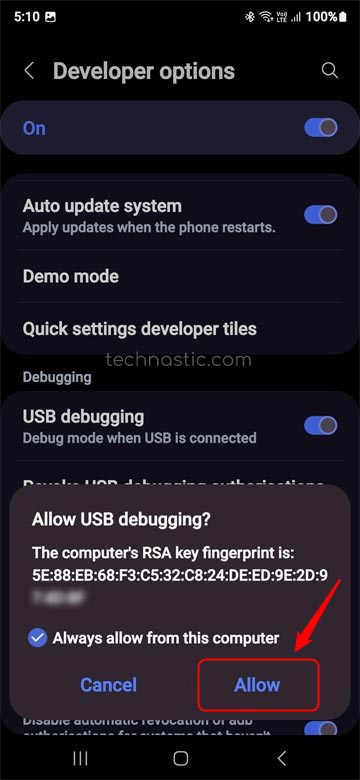
- When the connection is established, click the Power Menu > Reboot to Recovery option in WebADB.
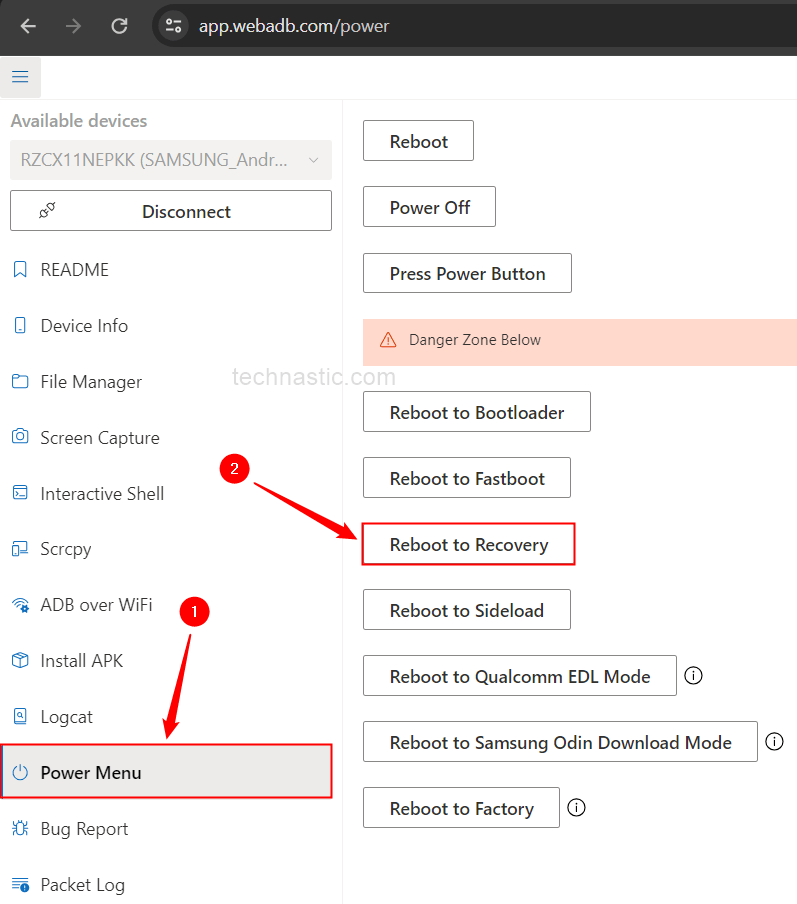
That’s it! Your Samsung phone or tablet will reboot into Recovery Mode.
6. Using QuickADB Tool
QuickADB is a versatile tool for Android enthusiasts. It can perform over ADB and Fastboot-related 60 tasks, including rebooting Android devices into Recovery Mode.
- Download QuickADB and run it.
- Enable USB Debugging on your phone and connect it to your PC.
- Select the ADB Tool tab and click the Reboot to Recovery option.
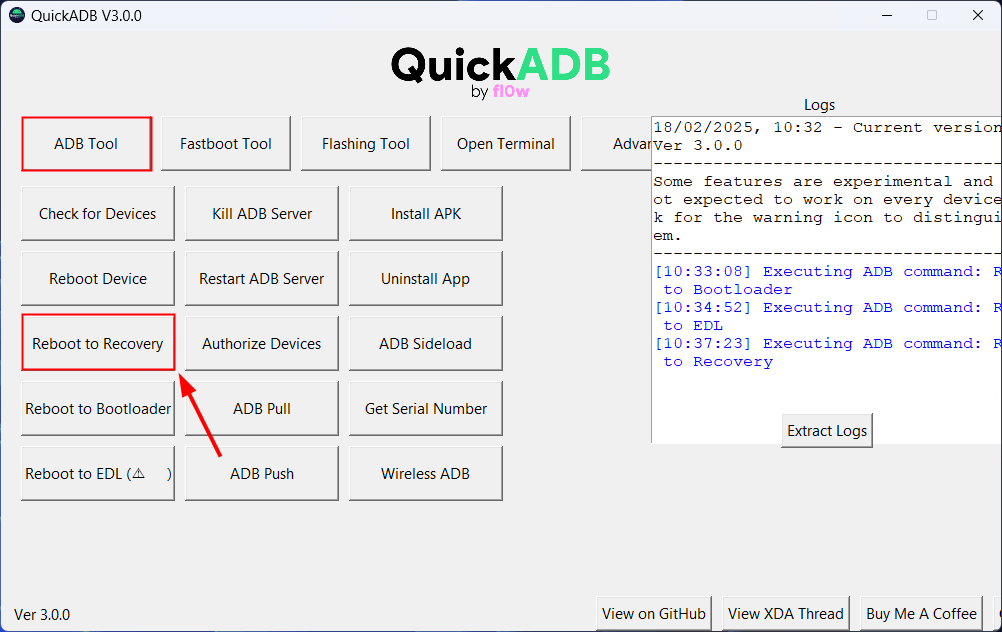
That’s it!
Android Recovery Mode Options Explained
Android Recovery Mode can help recover your device in tricky situations. It can perform a factory reset, wipe data, and cache partitions. These actions can help you fix some problems on your device. Moreover, you can also install the OTA ZIP package from Samsung to update your device software manually. It is designed to help troubleshoot and fix issues with your phone.
- Reboot to bootloader: You can use this option to enter the Download Mode.
- Apply update from ADB: By selecting this option, you can flash the OTA update.zip file using the ‘
adb sideload <file name>‘ command on your computer.
adb sideload ota.zip
- Apply update from SD card: This option lets you install an OTA zip saved on your Samsung phone’s storage.
- Wipe data/factory reset: As the name suggests, you can use this option to wipe all data on your Samsung device and reset it to the factory state.
- Wipe cache partition: The cache partition keeps all cache data, and by selecting this option, you can clean all the accumulated cache on your phone.
- Mount/ system: Using this option, you can mount the System partition on your Android and modify anything on this partition via your computer.
- View recovery logs: The recovery logs record all activities done via the recovery.
- Run graphics test: This option lets you test the GPU (graphics processing unit) on Android devices.
- Run locale test: This option is not supposed to be used by normal users and is meant for app developers. It helps developers “simulate the characteristics of languages that cause UI, layout, and other translation-related problems“.
- Reboot system now: Using this option, you can reboot your system in user mode.
- Power off: Select this option to turn off your Samsung phone or tablet.
- Repair apps: If any system app gets corrupted or you have issues using apps, you can use this option to repair the apps.

